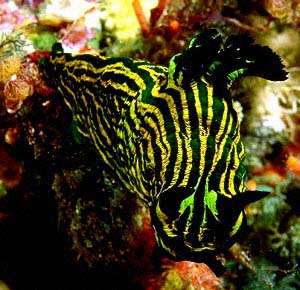
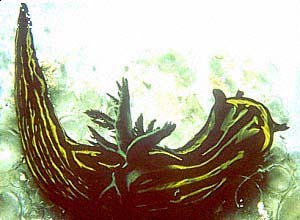
Roboastra luteolineata
(Baba, 1936)
Order: NUDIBRANCHIA
Suborder: DORIDINA
Family: Polyceridae
Subfamily: Nembrothinae
DISTRIBUTION
Originally described from Japan and reported here from New Zealand for the first time. It has previously been reported from Australia as Tambja affinis.
PHOTO
UPPER: Poor Knights Island, northeastern New Zealand. PHOTO: Ian Skipworth, Skip's Underwater Image Gallery .
LOWER: Gorgonia Hole, Heron Is, Capricorn Group, Great Barrier Reef, 10m. December 1980. PHOTO: Geoff Avern.
The most distinctive external feature of this species is the milky green markings between the rhinophores, which distinguish from other black nembrothids with yellow longitudinal lines down the body.
It has been identified in a number of popular books on Australian nudibranchs (Willan & Coleman, 1984., Coleman, 1989) as Tambja affinis (Eliot, 1904) but that species, originally described from East Africa, was described as having a single median yellow stripe. The suggestion in these books that it eats bryozoans (as Tambja affinis) is probably based on its misidentification as a species of Tambja. As a typical Roboastra, it most probably feeds on other nudibranchs. One typical feature of Roboastra are the large downward pointing oral tentacles which are probably associated with locating and tracking down their prey.
I am not sure if the animal identified as Roboastra luteolineata from South Africa in Helmut Debelius's book is that species as it does not seem to have the green marks between the rhinophores which are clearly present in Australian and Japanese specimens. It could however be a regional colour variety.
Reference:
• Baba, K. (1936). Opisthobranchia of the Ryukyu (Okinawa) Islands. Journal of the Department of Agriculture, Kyushu Imperial University, 5(1): 1-50, Pl. 1-3.
Rudman, W.B., 1999 (February 22) Roboastra luteolineata (Baba, 1936). [In] Sea Slug Forum. Australian Museum, Sydney. Available from http://www.seaslugforum.net/find/robolute
Related messages
Roboastra luteolineata laying eggs
May 6, 2010
From: Deb Aston
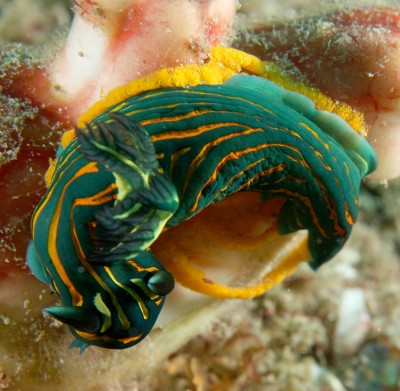
Thought you might like these pics of Roboastra luteolineata laying eggs for the forum.
Locality: ex HMAS Brisbane, Mooloolaba, 20 metres, Queensland, Pacific, 01 May 2010, Artificial Reef. Length: 40mm. Photographer: Deb Aston.
Deb Aston
dtaston@bigpond.net.au
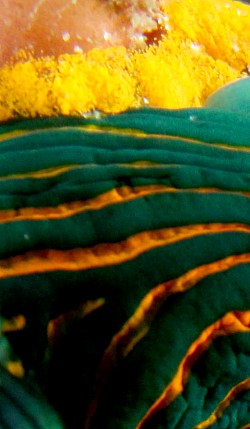
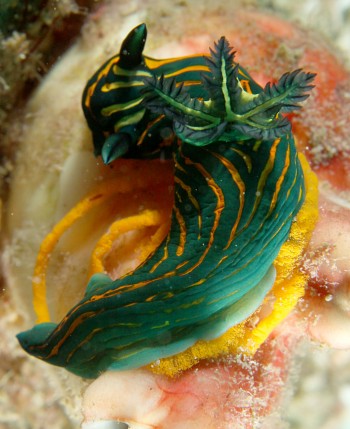
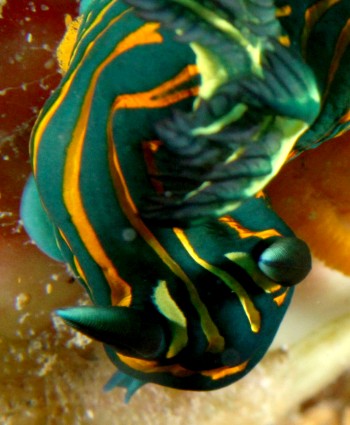
Thanks Deb,
It's nice to get photos of any of these species laying eggs. There are a group of species of the related genus Tambja [see T. affinis colour group] with a similar colour pattern to your Roboastra, but most of them lack the type of oral tentacle we can see in one of your photos. Fortunately the one species of Tambja with this type of oral tentacle, Tambja tentaculata, has a distinctively different colour pattern.
I have also included a close-up to show how the yellow lines on the body are really folds into which glands embedded in the skin have their opening. When these animals are disturbed they can exude a thick viscous white or yellow secretion to deter potential predators.
Best wishes,
Bill Rudman
Re: Roboastra luteolineata - Feeding behaviour!
August 4, 2007
From: Graham Abbott
Concerning message #20283:
Hi Bill,
I actually have a few photo journalists and top film makers interested in this behaviour. I will keep you posted and if you can get me in touch with any specialists in the field of behaviour please do let me know...
Cheers
Graham
seaslugs@diving4images.com
Abbott, G., 2007 (Aug 4) Re: Roboastra luteolineata - Feeding behaviour!. [Message in] Sea Slug Forum. Australian Museum, Sydney. Available from http://www.seaslugforum.net/find/20352Dear Graham,
Hopefully someone will get in touch with you
Best wishes,
Bill Rudman
Re: Roboastra luteolineata - Feeding behaviour!
July 24, 2007
From: Graham Abbott
Concerning message #19296:
Dear Bill,
I've recently noticed some other interesting behaviours of nudibranchs in relation to Roboastra luteolineolata. Have you ever heard of other nudibranchs sensing the trail left behind by nudibranchs and swimming off? I watched as a Tambja morosa, slowly went on it's way and went over the new path of the R. luteolineolata and alarmingly swam away as soon it touched the area where the R. luteolineolata had been. Can you please let me know if this is common behaviour?
Regards
Graham
seaslugs@diving4images.com
Abbott, G., 2007 (Jul 24) Re: Roboastra luteolineata - Feeding behaviour!. [Message in] Sea Slug Forum. Australian Museum, Sydney. Available from http://www.seaslugforum.net/find/20283Dear Graham,
This is a very interesting observation. There haven't been many studies on species of Roboastra, but the few that exist are focussed on the feeding behaviour of the predator - what prey does it choose, how does it sense its prey and how does it attack and eat it. These predators can certainly identify their prey from the mucous trail they leave. Megina & Cervera (2003) on their report on Roboastra europaea mention that one of its prey items, Tambja ceutae, has a spectacular defensive response when it touched a Roboastra or was touched by one. It would immediately and vigorously begin undulating its body and swim away. From your description Tambja morosa can identify some chemical in the mucous trail of R. luteolineata as a warning of immediate danger, and so elicit the same escape response. I can't say whether the animal you observed has learnt to do that from past experience or whether it is an instinctive reaction.
It definitely a research project for a student who wants to escape to warm waters for a while.
-
Megina, C. and Cervera, J. L. (2003) Diet, prey selection, and cannibalism in the hunter opisthobranch Roboastra europaea. Journal of the marine biological Association, U.K. 83: 489-495
Best wishes,
Bill Rudman
Roboastra luteolineata - Feeding behaviour!
January 23, 2007
From: Graham Abbott
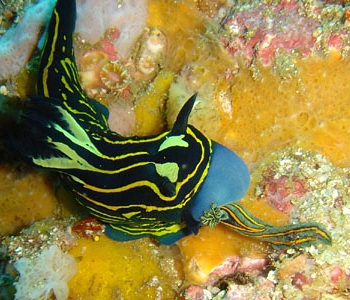
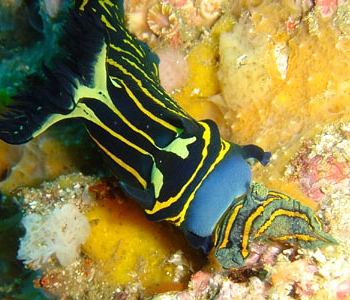
Hi Bill,
I have a question about some feeding behaviour I have recently witnessed and photographed. I have a few great sites where we can find the cannibal nudibranch Roboastra luteolineata and I've been observing them fairly closely recently. On my most trip out I photographed a very interesting sequence in which the cannibal nudi ate a spat out another nudibranch twice. I can only think that the other nudibranch is a hydroid eater, certainly looks like it with the skin colouration, to me it seems kind of like a C. willani which I do believe is a hydroid eater and ingests the hydroid into it's skin, is this correct?
Locality: South Rinca, Komodo, 8m, Komodo, Indonesia, 14.1.07, Large pinnacle. Length: no exact data!. Photographer: Graham Abbott.
I don't have any of my ID books with me, they are all out on another live aboard at the moment. I am hoping you can help me ID the lucky nudi that got away and let me know if it is indeed a poisonous species.Look forward to hearing back from you when I get back from my next trip!
Kind regards
Graham
graham@diving4images.com
Graham Abbott, 2007 (Jan 23) Roboastra luteolineata - Feeding behaviour!. [Message in] Sea Slug Forum. Australian Museum, Sydney. Available from http://www.seaslugforum.net/find/19296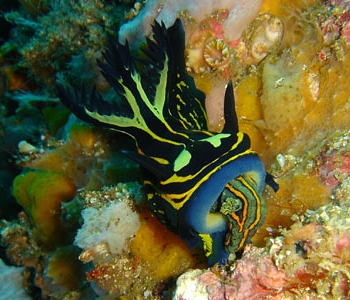
Dear Graham,
Thanks for the interesting sequence of photos. The fortunate 'prey' animal is very similar to a photo I have identified as Tambja tentaculata [message #14883]. We don't know much about that recently named species, but if it is like other species of Tambja, it will feed on bryozoans. Chromodoris willani is quite different in shape and colour, and is a sponge feeder.
Nudibranchs of the genus Roboastra are well-known as hunters, but it seems they restrict their prey to other nudibranchs of the family Polyceridae. They certainly seem to eat smaller members of their own species, so I guess you can call them cannibals, but they are not exclusively cannibals. The two species most studied are the tropical American R. tigris which feeds on Tambja abdere and T. eliora, and the European R. europaea, which feeds on a variety of polycerids (Megina & Cervera, 2003). From work on R. tigris, we know that distasteful chemicals are incorporated in tissues of the bryozoan-feeding species of Tambja, and then transferred to the Roboastra, when it eats them (Carte & Faulkner, 1986). I presume something similar could happen with Tambja tentaculata and R. luteolineata, but I doubt it would lead to the Roboastra rejecting the Tambja. It is possible the Roboastra was just being greedy. These hunters seem to attack by reflex action whenever they come across prey. Perhaps it discovered it didn't really have room inside once it started swallowing.
-
Carte, B. & Faulkner, D.J. (1986) Role of secondary metabolites in feeding associations between a predatory nudibranch, two grazing nudibranchs, and a bryozoan. Journal of Chemical Ecology, 12(3): 795-804.
-
Megina, C. and Cervera, J. L. (2003) Diet, prey selection, and cannibalism in the hunter opisthobranch Roboastra europaea. Journal of the marine biological Association, U.K. 83: 489-495.
Best wishes,
Bill Rudman
Roboastra luteolineata eating Nembrotha kubaryana
February 7, 2006
From: K. Anderson
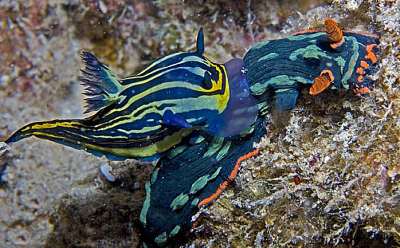
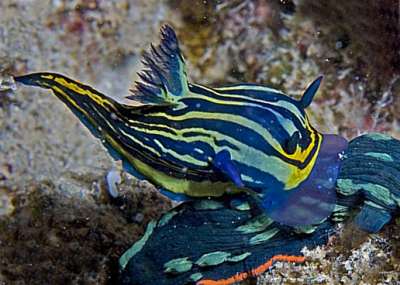
Found this tenacious Roboastra luteolineata beginning to devour a larger Nembrotha kubaryana yesterday. I watched for quite a while and returned to the action repeatedly through the dive - no matter what the N. kubaryana did, the R. luteolineata hung on. At one stage the predator was hanging off the prey by its mouth only before gaining a grip and piggybacking.
You can see the definitive oral tentacles that help ID this as R. luteolineata (instead of Tambja affinis ). You can also see that both species have bits sticking out their sides; I thought these were their sexual organs. Is there some reaction that takes place to cause this and if so, can you explain?
Locality: Lighthouse Bay, Ningaloo Reef, Western Australia, Indian Ocean. Depth: 12 m. Length: R. luteolineata 3 cm; N. kubaryana 6 cm ish. 04 February 2006. limestone/hard coral reef; sandy surrounds. Photographer: Kristin Anderson
Kristin Anderson
kristin@OceansByAnderson.com
Anderson, K.J., 2006 (Feb 7) Roboastra luteolineata eating Nembrotha kubaryana. [Message in] Sea Slug Forum. Australian Museum, Sydney. Available from http://www.seaslugforum.net/find/15757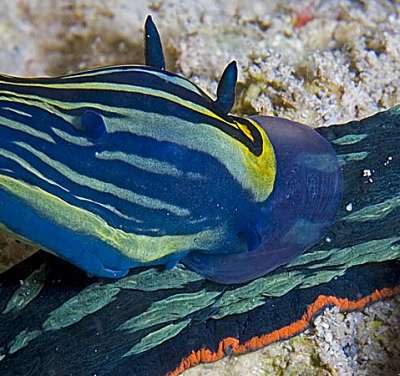
Dear Kristin,
The feeding behaviour is enough to separate the Roboastra from a bryozoan feeding Tambja. This is a nice observation as it is only the third record we have of this species feeding - all three observations being recorded on the Forum. Nembrotha morosa, Tamba verconis, and now N. kubaryana.
Concerning the reproductive organs protruding. I suspect this is to do with the nature of the body rather than any misplaced hormones. These animals have no hard skeleton so their shape is totally dependent on muscles working against their hydroskeleton. They are in fact a bag of watery blood. If you think of a rubber glove with its fingers popped inside out. If you fill the glove with water one or more of the fingers is going to pop out when the pressure increases enough. You can see that the Roboastra has pushes all its fluid to the front half of the body, presumably to help push out the buccal bulb so it can engulf the Nembrotha. I suspect the partial eversion of the reproductive organs is result of the greatly increased pressure in that part of the body. I am not sure why Nembrotha has also partially everted these organs, but I guess quite a lot of cross-wires are occurring in its little brain as it fights for its life.
Best wishes,
Bill Rudman
Roboastra luteolineolata from Great Barrier Reef
December 19, 2005
From: Pasquale Pascullo
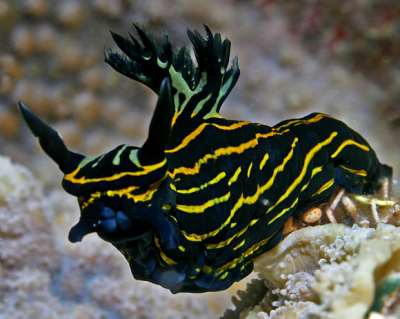
Hello Bill/everyone
I am real new to this site and id'ing nudi's
we are working on this one and was wondering if this was a Roboastra luteolineolata...
through pics and others, it seems so, just not totally sold on this yet. now that I have learned so much about it, if it is, I should have spent the whole dive with it, as for sure, this was a very active nudi and the descriptions of being a hunter, I look back thinking what I could have found maybe?
Dive Site called Monique, Norther Outer Reefs, Great Barrier Reef, Australia, Depth: 30 ft. Length: 3/4 inches. 1 December, 2005. Photographer: Pasquale Pascullo
ciao
Pasquale
NYC/NY is home.
pp@ppfotos.com
Pascullo, P., 2005 (Dec 19) Roboastra luteolineolata from Great Barrier Reef. [Message in] Sea Slug Forum. Australian Museum, Sydney. Available from http://www.seaslugforum.net/find/15492Dear Pat,
Yes this is Roboastra luteolineolata. The long oral tentacles on either side of the [bluish] mouth are typical of species of Tambja, although there are a few species of Tambja [see Tambja tentaculata] which break the rule..
Best wishes,
Bill Rudman
Re: Feeding habits of Roboastra
July 10, 2004
From: Bieke Daneels
Hi Bill,
I just saw some footage of Roboastra luteolineata engulfing Tambja morosa, there is smoke development. Can you or Lucas Cervera describe this chemical reaction; how do they digest species as big as themselves?
Thank you,
Bieke.
biekedaneels@yahoo.co.nz
Daneels, B., 2004 (Jul 10) Re: Feeding habits of Roboastra. [Message in] Sea Slug Forum. Australian Museum, Sydney. Available from http://www.seaslugforum.net/find/12673Dear Bieke,
I would be interested to know where the video you looked at was taken? Was it in New Zealand? We know so little about the feeding behaviour of these animals that every record is important. Concerning the 'smoke' you noticed. Species of Tambja, Nembrotha and Roboastra have special skin glands which at times exude coloured secretions. These are probably defensive and appear to contain antifeedant chemicals from their prey, which in the case of Tambja would be an arborescent bryozoan.
How do they digest such large prey? I'm afraid carnivorous molluscs are not very very well mannered when it comes to eating. An animal such as your Roboastra will just have to sit for many hours hugely distended until its digestive enzymes dissolve its prey. I have commonly seen the worm-eating slug Melanochlamys cylindrica feeding on worms it can only half swallow and then be trapped for hours with its head jammed in coralline algal turf waiting for the part of the worm it has swallowed to be digested. Another example is the large tun shells Tonna which feed on sea cucumbers, often larger than themselves. They somehow extend their head to envelope the whole sea cucumber and then have to sit for hours with their head swollen and unable to fit back into their shell.
Best wishes
Bill Rudman
Roboastra luteolineata from Kapalai
June 4, 2003
From: Maliza
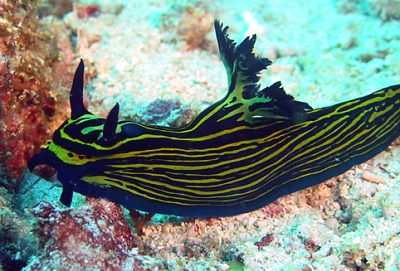
Hello Bill,
Please help identify the nudi in the attached photo. This guy was just moving along the bottom real fast. The funny thing is that a few of us (including myself) swore that the stripes were bright yellow, while others saw green, and the photo shows something in between. Thanks very much.
Location: Kapalai Island, off Borneo
Depth: abt 15m
Temp: 26C
Time: 8:30am
Size: abt 3in, quite fat
Maliza
emaliza@hotmail.com
Maliza, 2003 (Jun 4) Roboastra luteolineata from Kapalai. [Message in] Sea Slug Forum. Australian Museum, Sydney. Available from http://www.seaslugforum.net/find/10069Dear Maliza,
This is Roboastra luteolineata. This is a quite fast moving [for a nudibranch] hunter which feeds on other nembrothid nudibranchs [see message below].
Best wishes
Bill Rudman
More on Roboastra feeding
October 26, 2001
From: Ross & Diane Armstrong
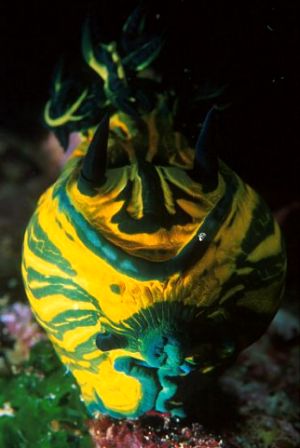
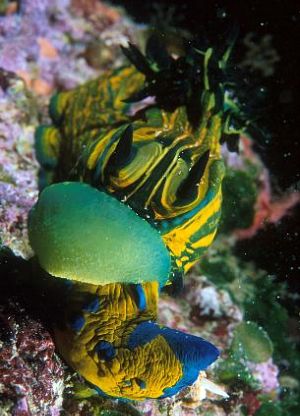
Dear Bill
To accompany our message about Roboastra luteolineata feeding on Tambja verconis here are a couple more shots. The upper one is after it has finished swallowing the Tambja and the lower one show it still in the process of getting it down.
Have to agree with it not being a Tambja.
Kind regards
Ross and Diane
ross@oceanwildlife.com
Armstrong, R. & Armstrong D., 2001 (Oct 26) More on Roboastra feeding. [Message in] Sea Slug Forum. Australian Museum, Sydney. Available from http://www.seaslugforum.net/find/5563Thanks Ross and Diane,
It really looks a happy Roboastra in the top photo.
Cheers,
Bill Rudman
Roboastra luteolineata vs Tambja verconis
October 25, 2001
From: Ross and Diane Armstrong
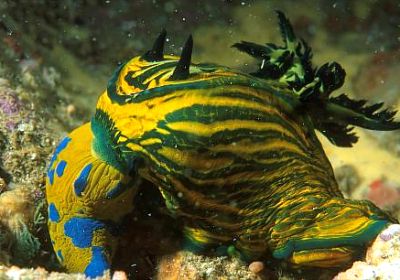
Dear Bill,
Thought you might enjoy these photos taken at the Poor Knights on Sunday. Diane made the discovery of Roboastra luteolineata with its mouth full of a Tambja verconis. The visibility was only about 5m so it did not make for the best photographic opportunities. We found it with less than half the T. verconis remaining and watched it slowly eat it down to less than a third remaining before we ran out of film. We went back to our boat and changed film but when we returned 45 minutes later it had finished its meal and looked full to bursting. What we found particularly interesting was how it extended its mouth to feed.
Kind regards
Ross and Diane Armstrong
ross@oceanwildlife.com
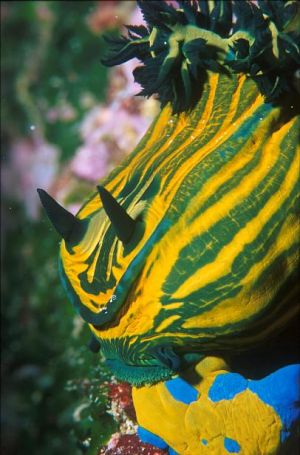
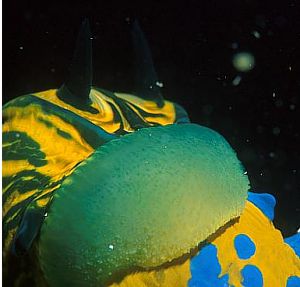
Dear Ross & Diane,
What a wonderful find - though a bit sad for the Tambja. It is certainly convincing support for my view that the striped animal is a species of the nudibranch-hunting genus Roboastra rather than the bryozoan-feeding genus Tambja. Actually in your upper photo we can see the whole food chain, for at the bottom left I can see some small branches of the bluish arborescent bryozoan Bugula dentata on which Tambja verconis feeds.
Although we call the mollusc radula their 'teeth' they work in quite a different way to vertebrate teeth. A carnivorous vertebrate like a dog or a lion woud use its teeth to bite off or tear off chunks of flesh and swallow them. The mollusc radula can perhaps be compared with having teeth on our tongue. Although they can be manipulated in ingenious ways, molluscs have never evolved a way to use the radula to bite of large chunks. In carnivorous hunters the teeth have become a set of grappling hooks which can grab and hold on to their prey while the the 'oral tube' which is a very extensible region just inside the mouth, extends out of the mouth by turning inside out, and wraps itself around the prey. Once it has done this it can then pull itself and the prey back into its body for digestion.
I think this is the first record of anyhting feeding on Tambja verconis and I don't know of any observations of Roboastra luteolineata feeding in Australia or NZ. Atsushi Ono has a couple of photos of it in his book feeding on another species of Tambja in Japan.
Thanks again for sharing this very interesting observation.
Best wishes,
Bill Rudman
Roboastra luteolineata from the Solomons
September 30, 2001
From: Scott Johnson
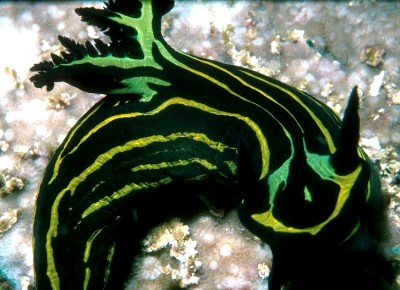
Hi Bill,
Does this look like Roboastra luteolineata? It was photographed at a depth of about 10 meters on a pinnacle reef west of Mbokonimbeti in Nggele (the Florida Group) in the Solomon Islands. It was quite a large animal; if my notes are correct, it measured about 100mm.
Scott.
johnson@kmr.ll.mit.edu
Johnson, S., 2001 (Sep 30) Roboastra luteolineata from the Solomons. [Message in] Sea Slug Forum. Australian Museum, Sydney. Available from http://www.seaslugforum.net/find/5326Thanks Scott,
Yes this is R. luteolineata. You can just see a bit of the oral tentacle in the shadow at the front of the animal.
Best wishes,
Bill Rudman
Roboastra cf. luteolineata from Sth Africa
July 3, 2001
From: Valda Fraser

Dear Bill
I photographed a "new" nudibranch last week while diving in an area I have never dived before. I think it is Tamba affinis, but I'd feel a whole lot better were you to say yes, or no!
Locality" Durban, SOUTH AFRICA , 15m
Date: June 2001
Size: 4cm
Regards
Valda Fraser
valdafraser@mweb.co.za
Fraser, V., 2001 (Jul 3) Roboastra cf. luteolineata from Sth Africa. [Message in] Sea Slug Forum. Australian Museum, Sydney. Available from http://www.seaslugforum.net/find/4639Dear Valda,
As I say at the top of the page I am not sure if this animal, which Debelius records from South Africa as T. luteolineata is really correctly identified or not. Typical R. luteolineata have a pattern of green markings which are absent in these South African animals. Perhaps it is a regional colour variation. It certainly has the prominent blue oral lappets typical of a species of Roboastra. As I say at the top of the page, Eliot's Nembrotha affinis has yet to be rediscovered.
I would call it Roboastra cf. luteolineata at present.
Best wishes,
Bill Rudman
Re: T. affinis v. R. luteolineata
April 24, 1999
From: Ross and Diane Armstrong
Hi Bill
Thanks for clearing that up. Your feedback is much appreciated. It is an interesting lesson for us not to accept everything we see in books as being correct. I find it particularly encouraging to have such a high level of interest in your comments from our underwater photography members. Hopefully we will be able to produce some more interesting photos of nudibranchs for you to add to your list.
kind regards
Ross Armstrong
ross@oceanwildlife.com
Armstrong, R. & D., 1999 (Apr 24) Re: T. affinis v. R. luteolineata. [Message in] Sea Slug Forum. Australian Museum, Sydney. Available from http://www.seaslugforum.net/find/801Dear Ross and Diane,
I'm glad that 'non-professionals' find the Forum interesting. That is at least half the reason I do it. When I give talks to Dive Clubs or get phone calls from people telling me about some interesting animal doing this or that I only wish they had recorded it because often this is the only way the 'profesionals', who are very thin on the ground, can find out about the habits of these fascinating animals. Any photo of a slug eating, mating, laying eggs etc, or even being present in a place you've never seen it before, could be of interest.
It's no coincidence that most of the early theoretical ecology was done by ornithologists. They had a huge army of birdwatchers out there accumulating mountains of information on birds - what they ate, where they were, how many eggs they lay etc etc. So any chance I have of encouraging more pairs of eyes to study Sea Slugs I take it. I'm more than happy to share what I know if it encourages more people to take up 'slugwatching'.
I have added your info to the Participants Page.
Best wishes,
Bill Rudman.
Tambja affinis v. Roboastra luteolineata
April 23, 1999
From: Ross Armstrong

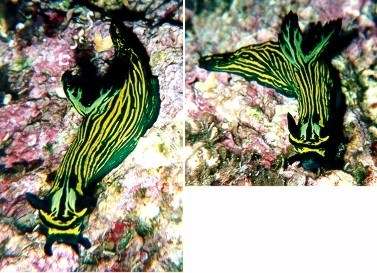
Hi Bill
Your e-mails re what we have previously referred to as Tambja affinis actually being Roboastra luteolineata has generated quite a bit of interest at our last Northland Underwater Photographic Society meeting.
Peter Snooks and Antony Syms, two keen photographers from Dargaville, have provided me with some of their photos for you to check. [top two are Peter's, lower two are Antony's] They have checked their photos against those shown in Helmut Debelius's book and are quite certain they match the nudibranch Helmut identifies as Tambja affinis.
I know that you were not sure if Helmut was correct is his book and have attached their photos for your expert opinion.
kind regards
Ross Armstrong
New Zealand
ross@oceanwildlife.com
Armstrong, R., 1999 (Apr 23) Tambja affinis v. Roboastra luteolineata. [Message in] Sea Slug Forum. Australian Museum, Sydney. Available from http://www.seaslugforum.net/find/799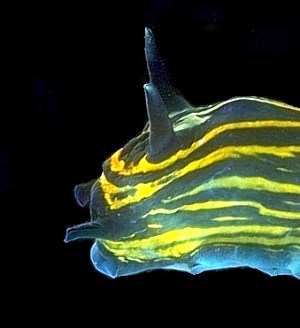
Dear Ross,
Whatever Helmut Debelius has in his book, the only way to know what an animal is, is to have a look at its anatomy and to refer to the original descriptions of the species. I can assure you that the animal you have sent me photos of, has an internal anatomy which makes it a member of the genus Roboastra. Apart from other features the radular teeth are very distinct. When I get a new scanner I've bought to work, (I seem to have bought a lemon and I've threatened the manufacturer to tell you all the make and model if they don't make it work!), I aim to put some radular photos up to show you.
Another very distinctive feature is the long prominent oral tentacles which can be seen in the photo alongside. Now why isn't it Tambja affinis? If we go back to the original description of that species as Nembrotha affinis Eliot, 1904, he clearly illustrates the radula of a species of Tambja. That alone shows that your animal cannot be the same as Eliot's. Your animal is identical in colour and anatomy to Roboastra luteolineata as first described by Baba in 1936, and more fully by Hamatani & Baba, 1976.
There's not much more to say. I'm afraid that although books with lots of beautiful colour pictures are becoming quite abundant as the costs of colour printing fall, taxonomists and research workers studying these animals have not become correspondingly more abundant. Because of this, we will have to expect a level of inaccuracy in many popular works.
Researching the names, relationships and biology of most groups of animals is a slow time-consuming task. I know our 'clients', such as interested divers, photographers etc, are impatient for the correct name, but unfortunately until more funds are provided for basic research it will be a slow haul.
Bill Rudman.
Rudman, W.B., 1999 (Apr 23). Comment on Tambja affinis v. Roboastra luteolineata by Ross Armstrong. [Message in] Sea Slug Forum. Australian Museum, Sydney. Available from http://www.seaslugforum.net/find/799Re: Roboastra luteolineata
February 24, 1999
From: Ross Armstrong
Hi Bill
Thanks for the e-mail. I have seen these only a few times and always at the Poor Knights and consider them uncommon in New Zealand. Next time I find one I will try the feeding experiment, if I can find a suitable victim.
regards
Ross
Ross@northpower.co.nz
Armstrong, R., 1999 (Feb 24) Re: Roboastra luteolineata. [Message in] Sea Slug Forum. Australian Museum, Sydney. Available from http://www.seaslugforum.net/find/611Robastra luteolineata - new for New Zealand
February 22, 1999
From: Ross Armstrong
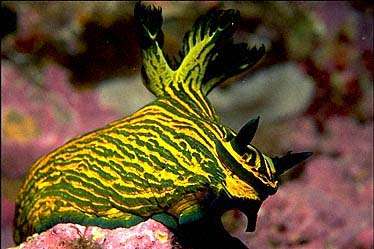
Dear Bill
Attached is a photo of Tambja affinis from the Poor Knights Islands [northeastern New Zealand].
regards
Ross
Ross@northpower.co.nz
Armstrong, R., 1999 (Feb 22) Robastra luteolineata - new for New Zealand. [Message in] Sea Slug Forum. Australian Museum, Sydney. Available from http://www.seaslugforum.net/find/586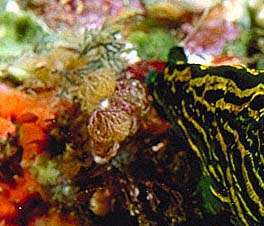
Dear Ross,
Thanks for the photo. This is Roboastra luteolineata. As I have discussed at the top of the page, this species has often been identified as Tambja affinis in Australia and New Zealand. Its anatomy shows that it is a species of Roboastra and so can't be Eliot's Nembrotha affinis, which, from his radula description, is really a species of Tambja. Species of Roboastra are interesting carnivores which prey on other nudibranchs. One species on the west coast of North America actively hunts down species of Tambja. In Ian Skipworth's photo at the top of the page there is a little colony of the arborescent bryozoan which looks like Scrupocellaria (see inset here). I wouldn't mind betting that your Roboastra luteolineata is looking for species of Tambja on the bryozoan. If you want to advance "science" it would be worth looking out for any feeding encounters between Roboastra and the species of Tambja which you find in the same locality. It might be interesting to "set up" a meeting between the two with a camera at the ready!
Best wishes,
Bill Rudman.
PS: if you get any pictorial evidence I would love a photo for the Forum.
Rudman, W.B., 1999 (Feb 22). Comment on Robastra luteolineata - new for New Zealand by Ross Armstrong. [Message in] Sea Slug Forum. Australian Museum, Sydney. Available from http://www.seaslugforum.net/find/586